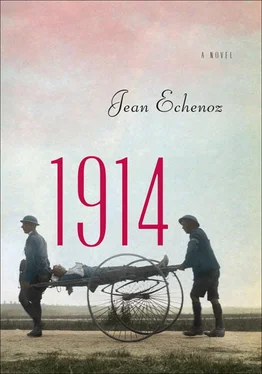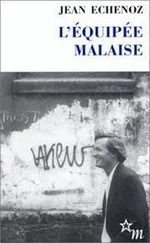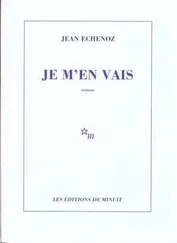In spite of their fatigue, before turning in for the night they tended to routine chores: laundry duty, inspection of shoes and feet. For distraction and relaxation, some men played cards, dominos, checkers, leapfrog, and even organized high-jump competitions or sack races. Arcenel, however, would simply carve his name with his knife, and Anthime just his initials along with the day’s date, on a tree or a wooden roadside cross. After the evening meal, the men would sleep, then set out again at the bugler’s call after harnessing themselves up, slinging their rifles, musette bags, and canteens over their shoulders, with cartridge pouches at their belts, but only after first hoisting onto their backs the 1893 model knapsacks nicknamed the Ace of Diamonds, made of a square wooden frame covered with a thick envelope of blackboard-green or licorice-brown canvas. [8] Ace of Diamonds: L’as de carreau means “the ace of diamonds,” but carreau is also the word for “square,” so this nickname is a play on words. The other popular name for the knapsacks was Azor, the French equivalent of “Fido,” because they were originally made of dog skin.
The men buckled them on with a pair of shoulder straps, each made of two pieces of leather joined by a brass rivet.
Empty, the pack weighed only one and a third pounds. It quickly grew heavier, however, with a first lot of regulation equipment carefully arranged inside and consisting of alimentary matériel (bottles of strong mint extract, coffee substitute, tins and sachets of sugar and chocolate, water bottles and cutlery of tin-plated iron, pressed iron mug, can opener, penknife), clothing (long and short underpants, cotton handkerchiefs, flannel shirts, suspenders, puttees), cleaning and maintenance products (clothes and shoe brushes, and for the weapons, tins of grease, polish, plus extra laces and buttons, sewing kit with round-tipped scissors), first-aid and toiletry articles (individual bandages, absorbent cotton wool, towel, mirror, soap, razor and strop, shaving brush, toothbrush, comb), as well as personal items (tobacco and rolling papers, matches and tinderbox, flashlight, nickel silver and aluminum bracelet with identification disk, individual service record booklet, and a small Prayer Book for Soldiers) .
Though that already seemed quite a load for one knapsack, the men then strapped various accessories to the outside. At the very top, on the rolled-up blanket placed over the tent canvas enclosing poles, stakes, and cords, would sit an individual mess tin, at a slight tilt to the rear so as not to bump the soldier’s head, while at the back of the pack a small bundle of dry wood for cooking supper at the bivouac would be wedged over a stewpot anchored by a strap running up across the mess tin, and from the sides of the pack would hang a few field tools inside their leather covers: ax or shears, billhook, saw, shovel, pick, spade pick, take your pick—along with a collapsible canvas bucket known as the water cow and a lantern in its canvas carrying case. By now this entire edifice would weigh at least seventy-seven pounds, in dry weather. Before sunshine gave way, as it must, to rain.
THIS MOSQUITO, at one o’clock, appears in air of a normal end-of-summer blue over the département of the Marne in northeastern France.
Let’s propel ourselves up toward this insect: as we draw closer, it gradually grows into a small plane, a Farman F 37, a two-seater biplane carrying two men, a pilot and an observer sitting one behind the other in crude seats barely protected by two rudimentary windshields. Buffeted by the wind, without the shelter of the closed cockpits that will eventually appear, the pair seem installed upon a narrow panoramic porch from which one can admire the landscape of nascent conflict: columns of trucks and soldiers on the move, cantonments and their parade grounds.
And on the ground itself, where all that is crawling and groaning and the earthbound troops are sweating, it is extremely hot, one of the last heat waves of this mid-August before the swing into autumn takes hold. But high in the sky, where it can be cooler, the men have bundled up.
Underneath their helmets and big protective goggles, dressed alike in leather jackets and trousers, overalls of black rubberized cloth lined with rabbit fur and reinforced with goatskin, plus fur-lined boots and gloves, the two men look all the more identical because their bodies are invisible, aside from their cheeks, jaws, and their mouths, as they try to talk to each other but prove unable to exchange more than poorly articulated exclamations they can hardly hear, deafened as they are by the eighty-horsepower engine, while the brisk air sweeps away their words. The two men seem cast in the same mold, figurines with faintly visible soldered joints, identical lead soldiers except for a brown scarf around the neck of the observer named Charles Sèze, the pilot being Alfred Noblès.
They are not armed, which is to say: not yet carrying the hundred-and-thirty-odd pounds of bombs this biplane can handle; the small machine gun on board is not operational. Although fixed to the fuselage, its design has still not produced satisfactory results—given that it’s difficult to aim and reload while piloting, especially since the synchronization gear for firing through the spinning propeller is not yet just right.
What’s more, they are not afraid, despite the novelty of this assignment for which they’ve received barely any training, having been sent on only this one reconnaissance mission. Noblès is at the controls, glancing briefly at the altimeter, compass, speedometer, and inclinometer. Charles Sèze holds an ordnance survey map open on his lap; his brown scarf is entangled with the straps of his binoculars and the aerial photography camera hanging heavily around his neck. As they fly they study the landscape, their only orders being to observe.
Later will come the dogfights and bombing, the no-fly zones over the enemy’s territory, the attacks from dirigibles and barrage balloons when things will, and very soon, become immeasurably worse. For the moment reconnaissance is all: taking photographs, reporting troop movements, calculating future adjustments of fire, noting the positions of lines, the capabilities and layouts of airfields and zeppelin hangars along with their outbuildings: depots, garages, command posts, dormitories, canteens.
So they’re aloft, keeping their eyes open, when another mosquito shows up way behind the Farman on the left, a new and almost imperceptible insect that neither Sèze nor Noblès notices at first and which, as they have done, will grow bigger and clearer. Wooden framework covered with canvas and adorned with the Maltese cross on the wings, rudder, and the wheels of the landing gear, a fuselage of duralumin: it’s an Aviatik biplane making a beeline toward the Farman that leaves little doubt as to its intentions, particularly since as it draws nearer, Charles Sèze spots an infantry rifle protruding from its cockpit and aimed unmistakably his way, upon which he immediately warns Noblès.
We are in the first weeks of the war and the airplane is a new mode of transportation, never before used in a military context. A Hotchkiss machine gun has been mounted on the Farman, true, but as an experiment and without ammunition, so it isn’t operational: the use of repeating weapons aboard planes has not yet been authorized by the powers that be, less because of their weight and imperfect performance than for fear that the enemy will take note and arm their planes in turn. Until things change and as a precaution, without paying too much attention to their higher-ups, flight crews do carry along rifles or handguns. Spurred by the sight of that infantry rifle, while Noblès begins evasive maneuvers with the Farman, zigzagging to keep out of the enemy’s line of fire, Charles rummages through a pocket of his overalls to pull out a Savage pistol especially adapted for aviation, fitted with a screen to catch spent casings so they won’t stray into the propeller.
Читать дальше









